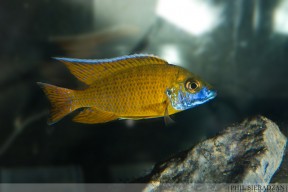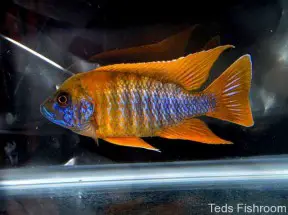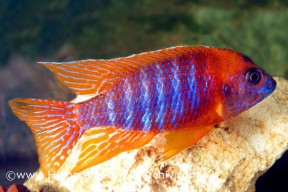Aulonocara baenschi
New Yellow Regal Peacock
Classification
Order: Perciformes Family: Cichlidae
Distribution
Endemic to Lake Malawi where it’s known from Usisya, Nkhomo reef, Benga (to the south of Chia lagoon), the Maleri Islands and Chipoka, all located along the lake’s western shoreline.
Habitat
Inhabits the so-called intermediate zones of the lake, where rocky shores give way to sandy bottoms with scattered rocks. The water is usually relatively shallow, between 4-6 metres, although it has been recorded as deep as 16 metres.
Maximum Standard Length
Male:? 100 – 120 cm? Female:? 75 – 90 cm
Aquarium SizeTop ↑
Minimum base dimensions of 120 ∗ 45 cm or equivalent are recommended unless keeping the fish in smaller aquaria for breeding purposes.
Maintenance
Arrange some piles of rockwork around the tank? but leave some open spaces between them and use fine sand as substrate so that it’s able to feed naturally (see ‘diet’).? Coarser options such as? gravel? or small pebbles can inhibit feeding, damage? gill? filaments and even be ingested with the potential of internal damage/blockages.? It will not harm plants so? hard water-tolerant species such as Vallisneria, Anubias or Sagittaria? species can be added if you wish.
Water quality is of the utmost importance since these cichlids are extremely susceptible to deteriorating water quality/swings in chemical parameters and should never be introduced to a biologically immature? aquarium. The best way to achieve the desired stability is to over-filter? the? tank? using a combination of canister filters and/or a? sump? system, and perform minimum weekly water changes of? 30-50%.
Water Conditions
Temperature: 25 – 29 °C
pH: 7.5 – 9.0
Hardness: 179 – 447 ppm
Diet
Aulonocara spp.? are? benthophagous? by nature employing a method of feeding whereby mouthfuls of? substrate? are taken and sifted for edible items with the remaining material expelled via the gills and mouth. They’re equally-skilled at hunting as grazing, tending to hover above the? substrate? until tiny movements are detected, and possess enlarged sensory pores on the head which assist in this technique.
The captive diet should contain a variety of high quality, fine-grade prepared foods plus small live and/or frozen? chironomid? larvae,? Tubifex,? Artemia, mosquito? larvae, etc.. At least some of the dried products should contain a high proportion of vegetable matter such as? Spirulina? or similar.
Home-made, gelatine-bound recipes containing a mixture of dried fish food, puréed shellfish, fresh fruit and vegetables, for example, can also work well and can be cut into bite-sized discs using the end of a sharp pipette or small knife. Rather than a single large meal offer 3-4 smaller portions daily to allow natural browsing behaviour as this seems to result in the best growth rate and condition.
Behaviour and CompatibilityTop ↑
A relatively peaceful species? although males tend to act aggressively towards? any fish with a similar colour pattern, so take care when selecting tankmates. Possibilities could include differently-patterened Copadichromis, Placidochromis, Otopharynx lithobates and peaceful Mbuna such as Labidochromis caeruleus. Other Aulonocara species are best avoided as most are able to hybridise, however, and the majority of Mbuna are excessively boisterous.
In all but the largest aquaria? it’s best to maintain just a single male alongside 4-6 females.
Sexual Dimorphism
Adult males are larger and more colourful than females.
Reproduction
Maternal mouthbrooder which will often spawn in a community set-up, but should be moved or maintained in a specific tank if the intention is to maximise yield. Males can be aggressive in pursuit of females so a ratio of a single male to 4 or more females is normally recommended in order to reduce the attention on any particular individual.? Some flattish rocks and open areas of sand? should be included to act as potential spawning sites.
The male will select one such? site and begin his courtship display and? when a female is willing she will approach? and lay a batch of eggs, after which she immediately picks them up in her mouth. The male possesses a number of ‘egg spots’ on the? anal fin and the female is also attracted to these, but when she tries to add them to? her mouth she actually recieves milt from the male, thus fertilising the eggs.
The female will carry brood for up to 4 weeks before releasing fully free swimming fry. She will not normally eat during this period and can be easily spotted by her distended mouthparts combined with a distinctive ‘chewing’ motion. If overly stressed the eggs? may be eaten or ejected prematurely meaning care must be taken if you decide to isolate a brooding female. It’s also worth noting that if a female is away from the colony for too long she may lose her position in the pecking order of the group so try to wait as long as possible before moving a female unless she is being actively harassed. Some breeders artificially strip the fry from the mother’s mouth at the 2 week stage and raise them separately from that point.
The fry may still have some yolk sac remaining when released and do not require additional food until this has disappeared. If released with? yolk sacs fully-absorbed, Artemia? nauplii? or similar can be offered immediately. They usually start to become sexable? at around the 4 month stage.
NotesTop ↑
This species may also be sold variously as ‘yellow regal cichlid’, ‘Baensch’s peacock’, ‘sunshine peacock’ and ‘Nkhomo-Benga peacock’. ? The easiest way to distinguish it from similar-looking congeners? is to look at the profile of the snout, which is steeper and more curved than in other species.




